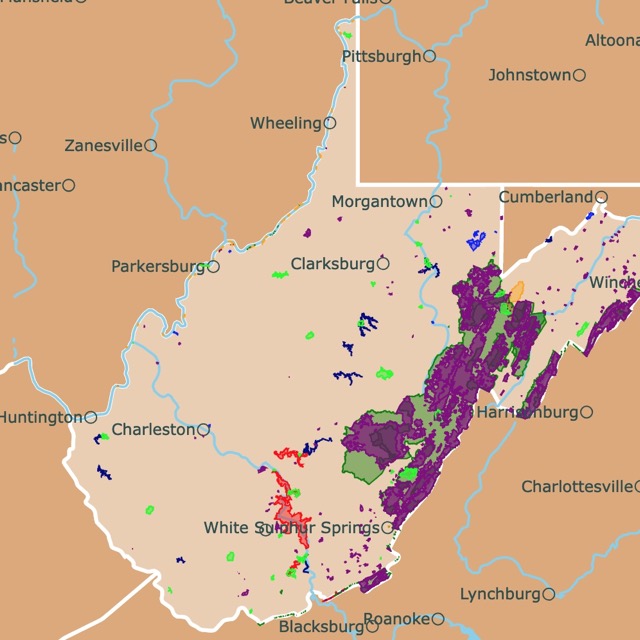Map of Ohio's Parks and Protected Areas
This interactive map shows the Locations, Names, Areas, and Details of National Parks, State Parks, National Forests, Tribal, and other Public Lands of Ohio. It also shows major cities and rivers for context. For more detail, zoom in. For more information, hover over the map, or scroll down.
| Key | |||||
|---|---|---|---|---|---|
| Lake or River | ◯ | City | |||
| Manager | |||||
| National Park Service | State | U.S. Forest Service | |||
| Fish and Wildlife Service | Tribal Lands | Bureau of Land Management | |||
| Department of Defense | U.S. Army Corps of Engineers | Other | |||
Geography of Ohio
Ohio is located on the northeastern edge of the Midwest region of the United States. To the north of Ohio lies Lake Erie, and to the east lies Pennsylvania. To the south, Kentucky and West Virginia. Indiana lies to the west, and Michigan is on the northwest boundary.

Ohio's physiographic features have influenced land use and human settlement patterns. Throughout most of the state, the river systems, topography, soils, and groundwater resulted from glacial activity millions of years ago.
Ohio could be divided into 5 regions:
- Till Plains: To the west is a large, fertile area and the beginning of America's corn belt.
- Blue Grass: Is in the south. It has cliffs, deep valleys, sinkholes, and caves. Here is Serpent Mount, believed to be formed by a meteor crash.
- Appalachian Plateau: This is the largest region, with rocky hills and steep valleys.
- Great Lakes Plains: This is a fertile area to the north.
- Lake Erie Shoreline: Has sandy and clay beach; source: NatGeo.
The lowest point is 433 feet (132 meters), located at the Ohio and Miami Rivers confluence near Cincinnati. Campbell Hill is the state's highest point, at 1,549 feet (472 meters), near Bellefontaine, Ohio.
Rain-fed streams, lakes, and reservoirs are the state's principal water source. Some of the state's major rivers include Ohio, Sciota, Wabash, and Great Miami.
Ohio's Climate
Ohio's temperatures are similar to those across the eastern and north-central United States.
Summer highs rarely reach 100 ℉ (38 ℃). Winter lows seldom drop below -20 ℉ (-29 ℃). Average July temperatures range between the mid-60s to the high 80s. January sees temperatures around the mid-30s with a low of about 20 ℉ (-7 ℃).
According to Weather Atlas, the average seasonal temperatures range between 90 (32.2) to -15 (-9.4).
The best time to visit Ohio would be spring, early summer, and fall.
Both spring and fall can be a bit wet, but the potential for outdoor recreation is there, and the scenery is incredible.
Ohio's Wildlife
Ohio's state tree, the Ohio Buckeye (Aesculus glabra), can commonly grow along creeks and rivers. The once glaciated areas contain timber stands, including ash, oak, walnut, maple, hickory, beech, and basswood.

Wildflowers like jack-in-the-pulpit, phlox, mayapple, and trillium bloom beautifully. Domesticated flower species grow throughout Ohio as well.
Around 350 birds species call Ohio home, and over half of them are native to the area.
Trout, bass, perch, muskellunge, and walleye are among the 150 (give or take) fish species found in the state's rivers, lakes, and streams.
Dozens of mammals roam the land in Ohio, including foxes, deer, opossums, raccoons, groundhogs, rabbits, and skunks.
The beaver and wild turkey populations are reestablished, and the number of coyotes has increased since the late 20th century.
Best Parks in Ohio
Cuyahoga Valley National Park
Cuyahoga Valley National Park is the red strip south of Cleveland.
While it's only a short distance from urban areas, Akron and Cleveland, Cuyahoga Valley National Park feels like another environment.
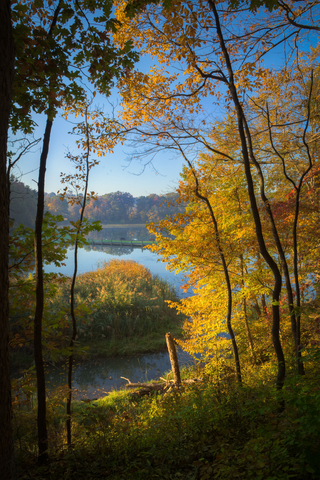
The park serves as a refuge for native wildlife and plants and provides pathways of discovery and recreation for visitors.
The Cuyahoga River flows through and around rolling hills and forests, providing an excellent site for water activities. Ride or walk the Towpath Trail, following the historic route of the Ohio and Erie Canal.
Birding, picnicking, hiking, paddling the river, fishing, biking, and questing are everyday outdoor activities visitors enjoy.
According to the Ohio & Erie Canalway, Questing Season runs from April 15th to November 15th, and it's an excellent way for participants to learn the history, culture, and heritage of the area.
Cuyahoga Valley National Park features activities, programs, and events for kids and youth. The scenic train ride is an excellent way to sit back and observe the nature surrounding you.
Visitors can ride through the valley and along the Cuyahoga River with opportunities to spot beavers and bald eagles.
The Ohio and Erie Canal Towpath Trail is open 24-hours and has multiple access points. The path has a crushed limestone surface but is wheelchair, stroller, and bike accessible.
Towpath Trail offers hikers, bikers, and adventurers 20 miles of exploration; Cuyahoga.
Wayne National Forest
Wayne National Forest is comprised of three large green units in southern Ohio. They are Marietta, Athens, and Ironton.
Wayne is located in the Unglaciated Allegheny Plateau, and it's the only national forest in the state. The forest began as part of a reforestation program.

At Wayne, you will find rock shelters, covered bridges, springs, and rocky hills covered with hardwood and pine.
Swimming, hiking, picnics, horseback riding, wildlife viewing, boating, and fishing are several outdoor recreational opportunities.
Wayne features a few excellent points of interest:
Kinderhook Trailhead is one of the forest's newest trail systems offering 12 miles of scenic riding opportunity.
Hikers, bikers, and horseback riders are all welcome to traverse the trail that winds through some steep hills, leading you through various vegetation, including; mature forests and bushland.
The Stone Church Horse Trail (named for the skeletal ruins from an old stone church) system offers 21 miles of scenic hiking or riding trails.
The Scenic Byway follows along the Ohio River and travels through the Ironton and Marietta units of the park. Loop trails offer alternative routes for exploration. A forest campground can be found along the byway with various paths and amenities.
The Monday Creek area at Wayne National Forest offers excellent riding for OHVs or Off-Highway Vehicles. The trail system, north of Nelsonville, Ohio, offers 75 miles of trails for OHV riding, mountain biking, and hiking.
Visitors will find loading ramps at the White Oak and New Straitsville Trailheads; Wayne.
Ottawa National Wildlife Refuge
Ottawa National Wildlife Refuge is a large orange area in northern Ohio.

The Ottawa National Wildlife Refuge protects a network of grasslands, wetlands, and forests that provide habitats for various migratory birds, local wildlife, and threatened and endangered species.
This land complex spans more than 8,000 acres and is recognized with global significance for its value to nature.
Visitors can enjoy birdwatching, hunting, and outdoor recreation, including archery, auto tours, biking, boating, cross-country skiing, fishing, and hiking.
The park hosts various programs and events throughout the year, so keep an eye out for that; Ottawa.
Hopewell Culture National Historical Park
Hopewell Culture National Historical Park is represented by the red specks in southern Ohio.
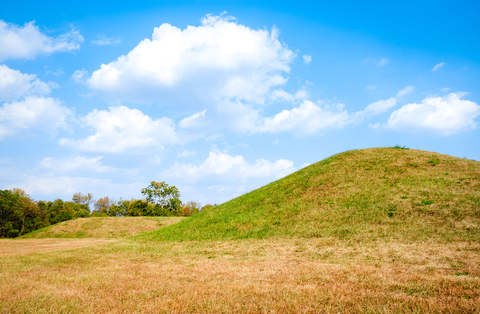
This Historical Park evolved partly from the former Mound City Group National Monument. According to NPS, the National Monument was established in 1923 to preserve the prehistoric mounds. Hopewell Culture National Historical Park was established in 1992.
The park is full of rich historical and cultural information about the Earthworks, mounds, and the Indigenous peoples that created them.
Visitors can enjoy an afternoon hike, followed by a picnic. The park film is insightful and makes for a great field trip with the kids; Hopewell.
Hocking Hills State Park
This Ohio State Park is the lime speck south of Lancaster.

The park has cliffs, gorges, and beautiful waterfalls to admire.
There are seven major hiking areas to explore in Hocking Hills; all are one-way trail systems. These include Old Man's Cave, Ash Cave, Conkle's Hollow, Rock House, Cantwell Cliffs, Whispering Cave Trail, and Cedar Falls.
The beautiful formations are the result of weathering on sandstone.
The park is open year-round from dawn to dusk, providing a unique experience for visitors who take to the trails.
Archery, boating, hiking, bridle trails for horseback riding, mountain biking, fishing, hunting, and picnics are popular activities visitors look forward to.
Special events and nature programs occur year-round. The Old Man's Cave Visitor Center features educational exhibits, a gift shop, and restrooms; Hocking Hills.
Maumee Bay State Park
This park is the lime speck east of Toledo.
Maumee Bay State Park has such an incredible landscape that creates a unique environment created by the union of Lake Erie and dry land.
The park also has a resort lodge, cabins, and a golf course. These amenities can be found among the lush marshes, woods, and scenic meadows blooming with wildflowers.
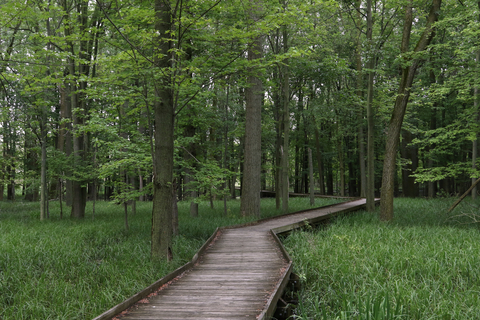
Over 300 bird species have been identified in Maumee Bay. The park's features include camping, fishing, swimming at the inland lake, exploring the nature center, a boardwalk trail, and the Storybook Trail; Maumee.
A closer look at the park reveals:
- A 7-lane archery range.
- Boating opportunity on the 57-acre inland lake.
- A couple of excellent fishing spots.
- Picnic areas with grills and picnic tables adjacent to the beach areas.
- Two sand beaches for swimming.
- Several miles of multi-use trails.
- A butterfly gazebo near the Nature Center.
- Sports courts for basketball, volleyball, and pickleball.
Mohican State Park
Mohican State Park is the green strip south of Mansfield.
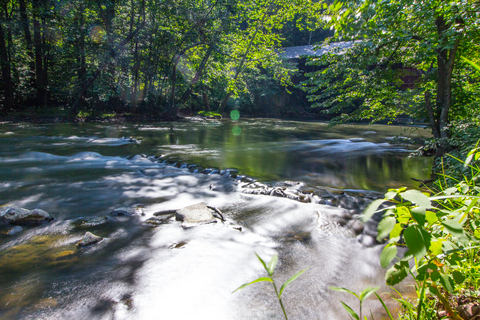
The incredible landscape of Mohican State Park looks impressive from the land and water. Clear Fork Gorge, the Mohican State Scenic River, and Lyon's Falls are some of the park's gems.
Overnight accommodations include a large family campground with a pool, a modern full-service lodge, a primitive camping site, and deluxe cabins; Mohican.
John Bryan State Park
John Bryn State Park is a lime speck east of Dayton.

This Ohio State Park is open every season, providing incredible views and picturesque scenery. The National Scenic River and Little Miami State River carved the stunning limestone gorge.
The gorge is a National Natural Landmark providing hikers with beautiful views throughout the park's 10 trails. Paddlers can access the river from a launch area outside of the park.
The Storybook Trail features a public rock climbing and rappelling area. Clifton Gorge State Nature Preserve is next to the park and offers additional hiking opportunities.
Scenic picnic areas and playgrounds are perfect for day-use visitors. A reservable day lodge is available for group get-togethers.
The campground is family-friendly and makes it possible for overnight guests to enjoy the rustic and natural surroundings; John Bryan.
Kelleys Island State Park
Kelleys Island State Park is a lime speck on Lake Erie, it encompasses over 600 acres to explore.

Kelleys Island is the perfect place to view Lake Erie. There's easy access to the shore, and the overnight accommodations are scenic and peaceful.
Boating, wildlife watching, fishing, and hiking are a few park visitor favorites.
The campground includes sites along the lake's shore. Several state nature preserves are nearby, and they're a must for hiking and birdwatching.
Kelleys Island is an excellent place for geology lovers. There is a large area where visitors can see grooves from ancient glacial activity. And, it's just a short walk from the campground; Kelleys.
According to Ohio History, Glacial Grooves is a National Natural Landmark just on the north side of Kelleys Island. It also states that the Grooves are "the largest easily accessible" grooves globally and can be seen seasonally.
Tar Hollow State Park
Tar Hollow is the lime speck southwest of Lancaster.
Deep ravines and dense woodlands are the backdrops of the picturesque setting of Tar Hollow State Park.
The pines' shortleaf and pitch gave the park its name, as the settlers used them for tar.
Dogwoods, redbuds, and various wildflowers steal the hillside's stage during the spring. While autumn provides an incredible palette of reds, browns, golds, and many hues of green.
The General Store and various buildings give the park those old-time vibes. You can pick up the basic essentials for boating, hiking, camping, swimming, and picnics; Tar Hollow.
Lake Hope State Park
Lake Hope is a lime speck south of Wayne National Forest.
Lake Hope State Park comprises almost 3,000 acres of land within the Zaleski State Forest in the valley known as Big Sandy Run.
Visitors will find remnants of abandoned mining and iron-producing industries within the heavily forested park, landmarked by steep gorges with narrow ridges.
The wooded family campground is serene. There are various year-round cabins for families and groups, including the Laurel Lodge; Lake Hope.
Salt Fork State Park
Salt Fork is the lime area west of Wheeling.
Salt Fork State Park offers endless opportunities for outdoor enthusiasts with meadows, valleys, streams, and forests.
Boaters can take advantage of the park's two marinas and launch ramps, and hikers have a trail system offering a variety of trails that range in length and difficulty.
History buffs appreciate the historic Kennedy Stone House. The top-rated 18-hole golf course is a land of its own. Overnight accommodations are available, including a full-service resort lodge, a large campground, and deluxe vacation cabins; Salt Fork.
Deer Creek Lake State Park Ohio
Deer Creek Lake is the blue speck southwest of Columbus.
Deer Creek offers an incredible balance of rustic and modern facilities, satisfying the many outdoor enthusiast's needs.
The park is in a beautiful farming area and features a resort, large campground, marina, and a golf course.
Visitors who come to Deer Creek Lake State Park can enjoy fishing, boating, hiking, and camping. Meanwhile, they can also have modern luxuries at their fingertips.
The historical Harding Cabin peaks history buff's interests. Nature programs and events occur during the spring, summer, and early fall.
During winter, outdoor enthusiasts willing to brave the cold stop out for snowmobiling and ice fishing; Deer Creek.
Affiliate Disclosure
Databayou.com is a participant in the Amazon Services LLC Associates Program, an affiliate advertising program designed to provide a means for sites to earn advertising fees by advertising and linking to Amazon.com. Databayou.com also participates in affiliate programs with Clickbank, CJ, and other sites.
If you plan to visit one of these parks or hike some of these forests, I suggest you get some of these items found on Amazon.
- Intex Challenger Inflatable Kayak: This Kayak is made of vinyl, which is UV and puncture resistant. Carries 2 people; it has aluminum oars and a pump, and is designed for easy paddling.
- Cabin Tent: Sleeps 10 people and fits 2 queen air mattresses. It includes a divider, a back door, and a lantern hook.
- Outdoor Game Set): Ideal for the beach, camping, or even the backyard. This set includes sets for volleyball, badminton, and horseshoe ring toss.
Resources for Ohio's Protected Areas Map
The shapefiles with Ohio's state boundary lines, lakes, major rivers, and cities were downloaded from Natural Earth Data.
The Parks and Public Lands shapefiles for Ohio were downloaded from USGS.
This map will be updated with new data! To receive updates on this and more nature maps, join my email list!!!!!!!
Made by Luz K. Molina with D3.js.







